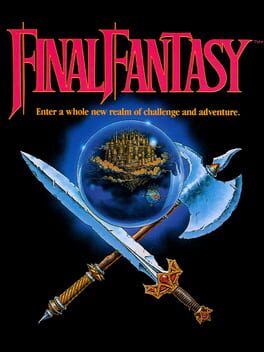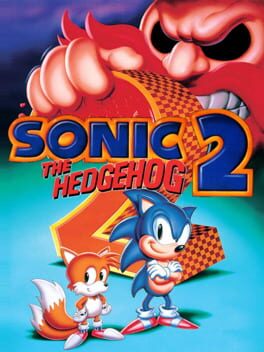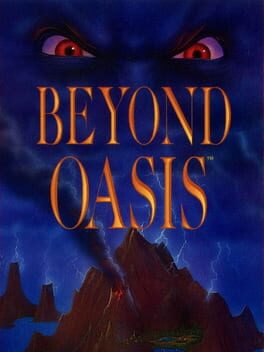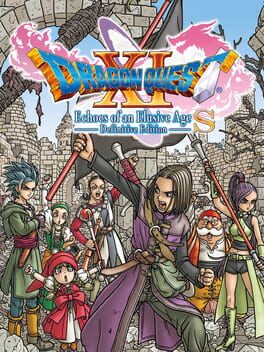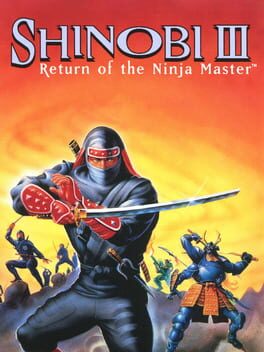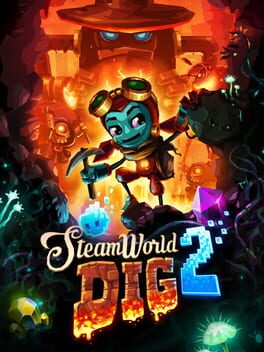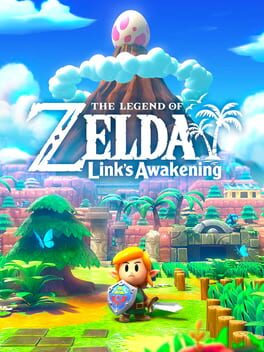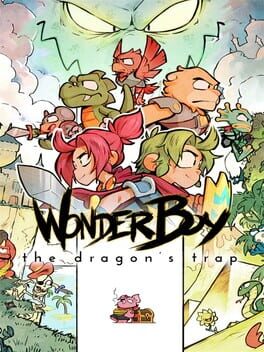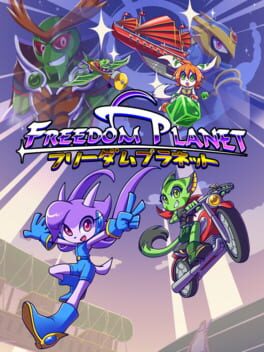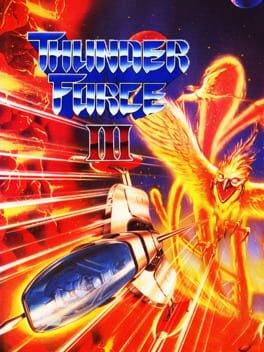GhaleonEB
BACKER
1987
Figured the best way to start playing the Final Fantasy games was to start at the beginning. I was struck by the ambition: the story and game mechanics, for the time, are really something (even if some aspects of the story went over my head thanks to the poor translation). It was neat to see the foundation of so many tropes established, most of which can't touch on without getting into spoilers. The basic turn-based combat is great, and the distinct character classes added a lot to it.
I'd probably rate this higher if I had played it back on release and had a better understanding of the impact, as well as some nostalgia for it. But as it was, the first Final Fantasy was still a very solid, fun RPG that surprised me in many ways. Look forward to replaying it as the recently released pixel remaster.
Played on NES Classic mini console.
I'd probably rate this higher if I had played it back on release and had a better understanding of the impact, as well as some nostalgia for it. But as it was, the first Final Fantasy was still a very solid, fun RPG that surprised me in many ways. Look forward to replaying it as the recently released pixel remaster.
Played on NES Classic mini console.
1992
Revisiting Sonic 2 after a couple decades, I'm once again struck by how this is both a perfect sequel and a conservative one. There's been a huge expansion in level variety over the first game, reimagined (but not necessarily better) bonus modes, tons of new ideas in the stage designs, a great new sidekick (Tails rules) and a soundtrack that somehow tops the legendary original.
On the flip side, there's only one new move (the now-iconic spin dash), zero new power ups, and gameplay that is only subtlety - those smartly - refined. And the traumatizing drowning music is still there, so that's a half star gone right there.
Otherwise, yeah, this is a stunning platformer and still a reference point for how to make a great sequel: do everything the original did, only bigger and better, and don't screw up anything it did well.
Played on Genesis mini.
On the flip side, there's only one new move (the now-iconic spin dash), zero new power ups, and gameplay that is only subtlety - those smartly - refined. And the traumatizing drowning music is still there, so that's a half star gone right there.
Otherwise, yeah, this is a stunning platformer and still a reference point for how to make a great sequel: do everything the original did, only bigger and better, and don't screw up anything it did well.
Played on Genesis mini.
On paper, this is a pretty typical metroidvania: start out with basic movement and abilities, get a handful of upgrades - yes, there's a crucial double-jump - and overcome obstacles to find new areas, clear out dungeons and their bosses, and then, um find Teddy. There's the retro pixel art style, simple backgrounds, and mysterious world with secrets to uncover.
In execution, Finding Teddy 2 is a special game. It has an ethereal, odd tone about it throughout, with lots of space in the audio for silence and ambiance. It refuses to explain itself: you get items, but are not told what to do with them. Figuring out mechanics, story and where to go next is never spoon-fed to the player. Even understanding basic mechanics requires keen observation of the environmental details.
Beneath all that opaqueness, there is a whimsy fluttering along the edges. Some decidedly comic characters are found in dire straits, for instance. And there are some terrific mechanics, such as the crucial musical tone system and how that can lead to multiple discoveries.
I plan to revisit this one soon; it left a lasting impression on me.
In execution, Finding Teddy 2 is a special game. It has an ethereal, odd tone about it throughout, with lots of space in the audio for silence and ambiance. It refuses to explain itself: you get items, but are not told what to do with them. Figuring out mechanics, story and where to go next is never spoon-fed to the player. Even understanding basic mechanics requires keen observation of the environmental details.
Beneath all that opaqueness, there is a whimsy fluttering along the edges. Some decidedly comic characters are found in dire straits, for instance. And there are some terrific mechanics, such as the crucial musical tone system and how that can lead to multiple discoveries.
I plan to revisit this one soon; it left a lasting impression on me.
2018
I didn't think I could beat Celeste. I'm not that great with tough platformers, and Celeste is a tough platformer. But here's the thing: Celeste wanted me to beat it. It told me I was good enough, encouraged me to learn from every one of my (thousands of) deaths, and to keep trying. In the end, the game was right. I could do it, and reaching the apex of the mountain made me so happy.
I love these characters. I love the soundtrack. I love that the game lifted me up every time I fell down. In a very meta-way, Celeste the game became my own Celeste mountain to clear, something I did because it was there and I NEEDED to do it. Celeste is one of the best fusions of theme, story, character and game design ever made.
I love these characters. I love the soundtrack. I love that the game lifted me up every time I fell down. In a very meta-way, Celeste the game became my own Celeste mountain to clear, something I did because it was there and I NEEDED to do it. Celeste is one of the best fusions of theme, story, character and game design ever made.
1994
Beyond Oasis is the answer to the question, what if the developers of Streets of Rage 2 made a top-down action-RGP? Ancient's vibrant, decidedly unique adventure as clever as it is unusual, and it's those aspects that make it hold up so well decades later.
Wielding spirits as companions, weapons, puzzle keys and as tools to progress through the world and gain resources is a remarkable feat of game design. As with the early Zelda games, there are secrets packed into every inch of the game, and he solutions are often very clever, requiring keen observation, experimentation or both.
The combat design is very Streets of Rage 2, as would be expected from Ancient. Combos, power moves, an abundance of weapons and the freedom to deal with your enemies with the tools of your preference make each encounter a lot of fun. On the downside, movement can be clunky at times when it needs to be precise. Bosses are tough and unique, capping dungeons that range from the humble water shrine to sprawling mazes.
The music is divisive, and is the aspect that has probably aged the worst, but it's a unique use of the Genesis synth and one that suits the tone of the game well. All in all this is a gem and one I love revisiting.
Played on Genesis Mini.
Wielding spirits as companions, weapons, puzzle keys and as tools to progress through the world and gain resources is a remarkable feat of game design. As with the early Zelda games, there are secrets packed into every inch of the game, and he solutions are often very clever, requiring keen observation, experimentation or both.
The combat design is very Streets of Rage 2, as would be expected from Ancient. Combos, power moves, an abundance of weapons and the freedom to deal with your enemies with the tools of your preference make each encounter a lot of fun. On the downside, movement can be clunky at times when it needs to be precise. Bosses are tough and unique, capping dungeons that range from the humble water shrine to sprawling mazes.
The music is divisive, and is the aspect that has probably aged the worst, but it's a unique use of the Genesis synth and one that suits the tone of the game well. All in all this is a gem and one I love revisiting.
Played on Genesis Mini.
I played this game some time ago. and much of it has stayed with me. I loved every main character, their individual story arcs, and how they pulled together into a team. Sylvanado and Jade and Veronica were my favorites, but they'll all so great.
I love old school turn-based combat and DQXI has a perfect implementation, keeping it simple while layering on interesting systems that encourage different party mixes and strategies. Crafting is similarly deceptively simple, and ultimately very satisfying (and important!). Every game system is well thought out and realized, and ties into the whole seamlessly.
I could say more about the story (incredible) or the setting (memorable and fun to explore), or the characters (vividly realized) but in the end, this is basically a perfect RPG, where everything works. I loved it.
Played on retro mode (2D pixel art), through to the end credits. Did not play the epilogue as I was satisfied with the conclusion.
I love old school turn-based combat and DQXI has a perfect implementation, keeping it simple while layering on interesting systems that encourage different party mixes and strategies. Crafting is similarly deceptively simple, and ultimately very satisfying (and important!). Every game system is well thought out and realized, and ties into the whole seamlessly.
I could say more about the story (incredible) or the setting (memorable and fun to explore), or the characters (vividly realized) but in the end, this is basically a perfect RPG, where everything works. I loved it.
Played on retro mode (2D pixel art), through to the end credits. Did not play the epilogue as I was satisfied with the conclusion.
Shinobi III is one of the best action games on the Genesis and still the best game in the very good Shinobi series. Everything clicks - the controls are tight and once mastered allow for precision movement. Which is good, because by the end of the game, precision movement is required. The move set is greatly expanded from Revenge of Shinobi. Musashi can sprint now, enabling speedy travel through levels and a way to quickly close the distance on enemies, capped with a lunging attack. Jump kicks, wall jumps, clinging to and clambering across ceilings - these actions once mastered enable us to flow through levels in style, and it feels amazing to not just overcome the challenges of the game, but doing so with style and a flourish.
The graphics are exceptional, with excellent animation for all characters and enemies, good effects work and clear, well detailed environmental and character designs. Every level is given depth through some of the most extensive parallax on the Genesis. The soundtrack is somehow up to the task of following Yuzo Koshiro's legendary work in Revenge of Shinobi, with a widely varied score spanning tracks that are slower and atmospheric when it suits the level to straight up rock (the jet ski sequences). Every track is great, and I still listen to this OST regularly all these years later.
But the true star here is the level design: every stage introduces new ideas and challenges, and they slowly make increasing use of verticality and require exploration in order to progress. Each presents several initial opportunities to make use of moves like wall climbing to get a feel for it before later requiring it to both advance and find secrets. Pure action stages on horseback or the aforementioned jet ski break up the longer levels, and the game climaxes in a pair of long and very intense platforming stages that epitomize the 'tough but fair' game design, making the game incredibly salifying to clear. Everything from the health and ammo systems to the abundance of secret stashes of supplies is tuned to walk that line.
This was my favorite Genesis action game when I was a kid, and probably my most replayed game ever. Playing it again for the first time in many years, I was struck at how well it holds up. Solid game design never ages. This game simply rocks.
Played on Genesis mini.
The graphics are exceptional, with excellent animation for all characters and enemies, good effects work and clear, well detailed environmental and character designs. Every level is given depth through some of the most extensive parallax on the Genesis. The soundtrack is somehow up to the task of following Yuzo Koshiro's legendary work in Revenge of Shinobi, with a widely varied score spanning tracks that are slower and atmospheric when it suits the level to straight up rock (the jet ski sequences). Every track is great, and I still listen to this OST regularly all these years later.
But the true star here is the level design: every stage introduces new ideas and challenges, and they slowly make increasing use of verticality and require exploration in order to progress. Each presents several initial opportunities to make use of moves like wall climbing to get a feel for it before later requiring it to both advance and find secrets. Pure action stages on horseback or the aforementioned jet ski break up the longer levels, and the game climaxes in a pair of long and very intense platforming stages that epitomize the 'tough but fair' game design, making the game incredibly salifying to clear. Everything from the health and ammo systems to the abundance of secret stashes of supplies is tuned to walk that line.
This was my favorite Genesis action game when I was a kid, and probably my most replayed game ever. Playing it again for the first time in many years, I was struck at how well it holds up. Solid game design never ages. This game simply rocks.
Played on Genesis mini.
2018
I was quite moved by this game, even though I probably did not fully understand it. There's an emotional resonance in the stunning art design that meshed well with the themes on meditations on grief and regret.
I thought GRIS took a little too long to get interesting - bit too much walking straight - and was occasionally frustrated by pushing forward before I intended, leaving optional objectives behind with no way to return. But other than those issues, this was a beautiful and emotional puzzle game.
I thought GRIS took a little too long to get interesting - bit too much walking straight - and was occasionally frustrated by pushing forward before I intended, leaving optional objectives behind with no way to return. But other than those issues, this was a beautiful and emotional puzzle game.
2017
SteamWorld Dig 2 is the ideal sequel: It takes every idea in the first game and improves or expands on them, while keeping the core that made the original so fun intact. The digging feels better, the action is faster and more satisfying, movement is better, the world is MUCH larger, and the worldbuilding and story are both richly improved.
Essentially a mining game fused with a metroidvania, there's as much action and platforming this time around as digging, but integrated in a way that feels more natural than the first game. The story is stand-alone enough to be played without playing the first SteamWorld Dig, but if you have then the returning characters and the ways this story ties into the original are a treat.
I love the steampunk western setting and the breezy, atmospheric vibe the score sets: it's a world that is fun to hang out in, and even more fun to explore. I've replayed this game several times now, and will do so several more times. Really hoping we get a third entry.
Essentially a mining game fused with a metroidvania, there's as much action and platforming this time around as digging, but integrated in a way that feels more natural than the first game. The story is stand-alone enough to be played without playing the first SteamWorld Dig, but if you have then the returning characters and the ways this story ties into the original are a treat.
I love the steampunk western setting and the breezy, atmospheric vibe the score sets: it's a world that is fun to hang out in, and even more fun to explore. I've replayed this game several times now, and will do so several more times. Really hoping we get a third entry.
Blossom Tales is a charming Zelda-like with a lot of personality. The framing device is a grandpa telling his kids a bedtime story, and his narrative pops in and out of the story throughout. Even better, the kids will argue about what happens in the story - what kind of boss are you about to run into? What kind of puzzle is up next? And rather than be cosmetic, we get to choose which kids' idea grandpa goes with in the story - which shapes what we do next. It's not transformational, but it's a really neat way to integrate the story into the gameplay.
This is, unfortunately, one of the only really original ideas in the game. If you've played a 2D Zelda (or even another Zelda-like), then all of this will be familiar. Get four heart pieces to add a heart to the health meter; park bombs on cracked walls to break them open; get the bow and arrow for range combat and dungeon puzzle solving. It's all very familiar, but done well and with a lovely art style.
Wanted to mention the music in particular as a standout - Josie Brechner's score is a superb chiptune accompaniment to the game, often richly atmospheric (the frost zone them is incredible) and always setting a great mood for the dungeons and areas.
With some more original ideas I think this would have been more interesting, but it's a solid little game regardless.
This is, unfortunately, one of the only really original ideas in the game. If you've played a 2D Zelda (or even another Zelda-like), then all of this will be familiar. Get four heart pieces to add a heart to the health meter; park bombs on cracked walls to break them open; get the bow and arrow for range combat and dungeon puzzle solving. It's all very familiar, but done well and with a lovely art style.
Wanted to mention the music in particular as a standout - Josie Brechner's score is a superb chiptune accompaniment to the game, often richly atmospheric (the frost zone them is incredible) and always setting a great mood for the dungeons and areas.
With some more original ideas I think this would have been more interesting, but it's a solid little game regardless.
This was the first Zelda game I'd ever played, and it was a delightful way to start. The art style is really nice, cute and subtly stylish; the overall aesthetic is just kinda warm and comfy. Everything feels just right, from the gentle music to the controls.
The overworld is not huge, but it's a masterclass in efficiency: every inch of the map has a purpose, and sometimes more than one. I must have zig-zagged the island hundreds of times and was never boring due to the tight design and efficient use of space and shortcuts. Link's Awakening effortlessly rewards exploration and experimentation from the very beginning on thorough the end.
Not especially difficult, but satisfying none the less to clear dungeons, progress through the overworld and uncover secrets. I particularly enjoyed toting the shovel everywhere digging holes all over the island, and the fishing mini-game.
The dungeon maker activity is sadly very limited and not particularly enjoyable; finding blocks to unlock new parts of it was more fun than actually using it. But aside from that? This is a nearly perfect action-RPG and a really great introduction to Zelda. I've played games influenced by the early Zelda games all my life, but never the OG.
By the end, I found myself sad that it was drawing to a close. I really like these characters, and the world they populated was one I didn't want to leave. I suppose that's the ultimate success measure of an RPG: it created a world that I missed when I left it. Wonderful game I look forward to replaying.
The overworld is not huge, but it's a masterclass in efficiency: every inch of the map has a purpose, and sometimes more than one. I must have zig-zagged the island hundreds of times and was never boring due to the tight design and efficient use of space and shortcuts. Link's Awakening effortlessly rewards exploration and experimentation from the very beginning on thorough the end.
Not especially difficult, but satisfying none the less to clear dungeons, progress through the overworld and uncover secrets. I particularly enjoyed toting the shovel everywhere digging holes all over the island, and the fishing mini-game.
The dungeon maker activity is sadly very limited and not particularly enjoyable; finding blocks to unlock new parts of it was more fun than actually using it. But aside from that? This is a nearly perfect action-RPG and a really great introduction to Zelda. I've played games influenced by the early Zelda games all my life, but never the OG.
By the end, I found myself sad that it was drawing to a close. I really like these characters, and the world they populated was one I didn't want to leave. I suppose that's the ultimate success measure of an RPG: it created a world that I missed when I left it. Wonderful game I look forward to replaying.
This is a loving remake to one of my favorite games ever, Wonder Boy III: The Dragon's Trap on the Sega Master System. I'd played that game to death when I was a kid, and still periodically revisit it.
As a remake, it is very smartly designed. Fully remade with gorgeous hand-drawn animation and backgrounds, the bones of the game are none the less very faithful the original, with a few tweaks. The game has a toggle that can switch between the new, beautifully hand-drawn art and the original SMS pixel art, showing both how faithful the remake is and how clever many of the visual updates are. There's also a toggle for the music and sound, allowing combinations of retro graphics and/or sound, rather than all or the other. (I enjoy the original chiptunes a great deal, so I play with the new graphics and OG sound.)
The overall adventure is still the same, hopping from one animal form to another in order to unwind a curse that is put upon the titular boy (or girl, in this version! progress!) in the intro. The gameplay and world design holds up, with the only major indicator that of its roots as an 8-bit game being the decidedly horizontal level design.
There are some new ideas here, as while the original game had many secrets to find, this remake adds a few more, namely in the way the stones work and are found, leading to some of the few world design updates. These new areas have a very different feel than the OG game, but still integrate into it well.
I do wish saving worked a bit more like how it did in the original, and dying did so as well. And while they did add a password feature to mimic the original after fan requests, it's buried in menus and very counterintuitive to use. The world design is relatively simple compared to later metroidvania games, but as a whole it fits together beautifully.
All in all this is a great version of a great game and I'm really glad it exists. The modern return of Wonder Boy has been a lot of fun to experience, as a longtime fan of the series.
As a remake, it is very smartly designed. Fully remade with gorgeous hand-drawn animation and backgrounds, the bones of the game are none the less very faithful the original, with a few tweaks. The game has a toggle that can switch between the new, beautifully hand-drawn art and the original SMS pixel art, showing both how faithful the remake is and how clever many of the visual updates are. There's also a toggle for the music and sound, allowing combinations of retro graphics and/or sound, rather than all or the other. (I enjoy the original chiptunes a great deal, so I play with the new graphics and OG sound.)
The overall adventure is still the same, hopping from one animal form to another in order to unwind a curse that is put upon the titular boy (or girl, in this version! progress!) in the intro. The gameplay and world design holds up, with the only major indicator that of its roots as an 8-bit game being the decidedly horizontal level design.
There are some new ideas here, as while the original game had many secrets to find, this remake adds a few more, namely in the way the stones work and are found, leading to some of the few world design updates. These new areas have a very different feel than the OG game, but still integrate into it well.
I do wish saving worked a bit more like how it did in the original, and dying did so as well. And while they did add a password feature to mimic the original after fan requests, it's buried in menus and very counterintuitive to use. The world design is relatively simple compared to later metroidvania games, but as a whole it fits together beautifully.
All in all this is a great version of a great game and I'm really glad it exists. The modern return of Wonder Boy has been a lot of fun to experience, as a longtime fan of the series.
2014
Freedom Planet is a mostly excellent platformer. I loved the giant, sprawling levels and how richly the game rewards exploring them. The visuals are wonderful, with great character designs and tons of fun details in the colorful art.
Freedom Planet's roots as a Sonic fan game are on display, but that's not a bad thing as it's got a very strong personality of its own. In particular, the story and characters are very strong and memorable. The story gets a bit heavier than I expected given the early tone, but it sets the stakes well.
Lastly, the soundtrack is an all-time great. I picked it up on Bandcamp and listen to it regularly, just a joyful assortment of catchy tunes and fun instrumentation. Each paired stage featuring the same theme but remixed was a great choice.
The boss fights are the weakest aspect of the game, as I found they contributed to very uneven pacing. Most were simply not very fun to fight and ground the game to a halt. If the game excluded most of them I'd have enjoyed it more. I hope this aspect is improved in the sequel.
Played through the as Lilac campaign. Worth noting, every character has some unique levels, so there's more to find on a replay.
Freedom Planet's roots as a Sonic fan game are on display, but that's not a bad thing as it's got a very strong personality of its own. In particular, the story and characters are very strong and memorable. The story gets a bit heavier than I expected given the early tone, but it sets the stakes well.
Lastly, the soundtrack is an all-time great. I picked it up on Bandcamp and listen to it regularly, just a joyful assortment of catchy tunes and fun instrumentation. Each paired stage featuring the same theme but remixed was a great choice.
The boss fights are the weakest aspect of the game, as I found they contributed to very uneven pacing. Most were simply not very fun to fight and ground the game to a halt. If the game excluded most of them I'd have enjoyed it more. I hope this aspect is improved in the sequel.
Played through the as Lilac campaign. Worth noting, every character has some unique levels, so there's more to find on a replay.
1990
This is still my favorite shooter on the Genesis, and there's a whole lotta competition on the system. TFIII is one of those games where everything comes together perfectly to create something greater than the parts. The graphics are detailed with great parallax and animation; the soundtrack is an all-time great that I still listen to regularly (it recently got a CD re-release in Japan BTW); the controls are perfect; the action intense but fair, the challenge rising steadily but never becoming crushing.
It's all integrated into a vibe that is slick as hell. The level transitions are smooth and satisfying, boss fights emerge with a claxon warning and each with unique, jamming tunes. Weapon switching is fast, which is good because mastering the game means learning to do so on the fly rapidly. You can likewise change speeds instantly, and often need to in order to navigate tight passages. Even the UI is well-designed, doing its job efficiently and staying out of the way.
The levels are richly varied in design, scrolling all sorts of directions and speeds, and even the requisite "the level is fighting a giant ship" mission is done exceptionally well. The Hades mission and Orn bases are standouts, with the latter having one of my favorite soundtracks in any game.
The missing half star is because the bosses were unfortunately not balanced well - they all have nearly no health and die quickly even if you have little firepower, but some go down in low single digit seconds if you reach them powered up. (An issue fixed and then some in TF IV.) Still, this is a masterpiece right on through.
Played on Genesis Mini.
It's all integrated into a vibe that is slick as hell. The level transitions are smooth and satisfying, boss fights emerge with a claxon warning and each with unique, jamming tunes. Weapon switching is fast, which is good because mastering the game means learning to do so on the fly rapidly. You can likewise change speeds instantly, and often need to in order to navigate tight passages. Even the UI is well-designed, doing its job efficiently and staying out of the way.
The levels are richly varied in design, scrolling all sorts of directions and speeds, and even the requisite "the level is fighting a giant ship" mission is done exceptionally well. The Hades mission and Orn bases are standouts, with the latter having one of my favorite soundtracks in any game.
The missing half star is because the bosses were unfortunately not balanced well - they all have nearly no health and die quickly even if you have little firepower, but some go down in low single digit seconds if you reach them powered up. (An issue fixed and then some in TF IV.) Still, this is a masterpiece right on through.
Played on Genesis Mini.
This is a classic platformer that I had always wanted to play, but never had the chance until I got the Genesis Mini. I knew it had great animation and fun controls, and it did. While not long, every level has quite a few secrets to discover and unique gameplay and obstacles to tackle; it's fairly bursting with great ideas all the way through. The game feels joyful to play from the start, and keeps that all the way through.
It's an interesting snapshot of the lifespan of the Genesis. This seems like one of the earliest titles to really start to show the promise of the system, in a way a prelude of the incredible action games that came in the next few years. As is, Castle of Illusion is a solid hop and bop platformer with beautiful animation and music, coming right before the true greats hit the system.
Played on Genesis Mini.
It's an interesting snapshot of the lifespan of the Genesis. This seems like one of the earliest titles to really start to show the promise of the system, in a way a prelude of the incredible action games that came in the next few years. As is, Castle of Illusion is a solid hop and bop platformer with beautiful animation and music, coming right before the true greats hit the system.
Played on Genesis Mini.
